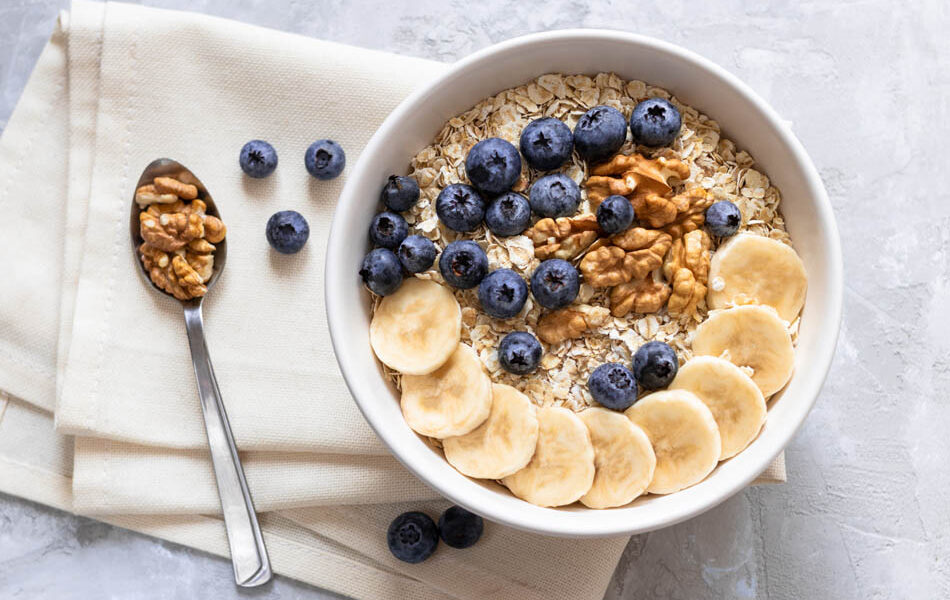Is Oatmeal Good for Diabetes?
One of the healthiest breakfast options is oatmeal. It contains lots of antioxidants and fiber. However, is it safe for people with diabetes to eat oatmeal?

Oatmeal is a form of porridge made from rolled, milled, or steel-cut oat grains. A single bowl of oatmeal is known to be the powerhouse of nutrition and offers multiple health benefits. It’s one of the few comfort foods that are equally delicious and healthy.
Oatmeal normally has a mild, sweet flavor and a creamy, occasionally chewy texture when cooked. Oats that have been soaked overnight are frequently consumed at room temperature, though they are typically served warm right from the stove.
Oatmeal helps in weight loss and is excellent for your heart’s health. But is it beneficial for those who have diabetes? Continue reading to learn more about oatmeal and its benefits for diabetes.
Is Oatmeal Good for Diabetes?
Oatmeal is healthy, and it is a fiber-rich breakfast option for people with diabetes. As long as it is consumed in controlled portions, it is less likely to cause blood sugar spikes than any other cereals.
Additionally, it has a low glycemic index (GI), and the carbohydrate content is mostly from fiber and not starches and sugars. The GI is a method for determining how quickly a food raises blood glucose levels.
Is Oatmeal Good for Type 2 Diabetes?
Oats can help lower A1C, fasting blood glucose, and total and “bad” LDL cholesterol levels in adults with type 2 diabetes. Oats’ beneficial qualities are mostly attributed to a special kind of fiber called beta-glucan, which slows digestion and increases satiety.
However, try to avoid instant ones or adding brown sugar as it might increase your carbohydrate intake. Include fresh fruit instead of dried fruit, as dried fruits have higher sugar levels and calories.
Does Oatmeal Raise Blood Sugar?
Oats have high fiber content that slows the absorption of sugar, preventing any post-meal spikes in blood glucose levels. But, having instant oatmeal or oatmeal that is loaded with sugar and unhealthy toppings will increase your blood sugar.
Which Oatmeal Is Best for Diabetes?
People with diabetes need to be mindful when selecting their oatmeal variety. All types of oatmeal are made from oat groats, the whole kernels harvested before being dehulled.
Oat groats are further processed to produce a variety of oats that can be used to make oatmeal. The more processed the oats are, the less fiber they have. Following is a list of different varieties of oatmeal:
Steel cut or Irish oats?
Steel-cut oats, also known as Irish oats, are most similar to the original, unprocessed oat groat. The groats are cut into bits using big steel blades to produce steel-cut oats. Compared to rolled or instant oats, they have a rougher, chewier texture and a nuttier flavor.
Additionally, they require more time to prepare; the typical cooking time ranges from 15 to 30 minutes.
They have a slightly high fiber content because they have undergone the least processing. The total fiber content present in a 40g serving of steel-cut oats is 4g, and 2g is soluble fiber.
They also have a lower GI of 53, which means that they are absorbed and digested more slowly by the body, causing blood sugar levels to rise more gradually.
Steel-cut oats are the best option for those trying to better regulate their blood sugar.
Rolled oats
Oat groats that have been steamed and flattened are known as rolled oats or old-fashioned oats. Due to their partial cooking, they are easier to prepare than steel-cut oats and have a milder flavor and softer texture.
It takes 2–5 minutes to make a bowl of rolled oats.
Rolled oats and Irish oats almost have the same nutritional value, but with a slight difference.
The fiber content in a 40g serving of rolled oats is 4g, out of which 0.8g is soluble fiber. The GI score of rolled oats is 56. Compared to Irish oats, rolled oats have a higher glycemic index because they have been partially cooked, which causes your blood sugar to rise more quickly.
Instant oats
Of the three oat types, instant oats have undergone the most processing. Before being rolled and pressed, they are first pre-cooked, dried, and then pressed slightly thinner than rolled oats.
They cook faster than steel-cut or rolled oats, but their texture is lost while cooking, and they often become mushy.
They also have the same nutritional benefits when compared to rolled or Irish oats, but the main drawback is that these flavored instant oats contain added sugar which might not be beneficial for someone who has diabetes.
Some brands may also contain sodium as a preservative, but you can find one without it.
Instant oat intake without all the unnecessary ingredients can be nutritious, but the more whole grains you consume, the slower they will be broken down, and the longer you will feel satiated.
Additionally, these oats raise blood sugar levels quickly, which is not good for people with diabetes. The GI of rolled oats is 56, whereas the GI of instant oats is 67.
The below table compares the nutritional value of steel-cut oats, rolled oats, and instant oats:
| Calories/Nutrient (per 40g) | Steel-cut oats | Rolled oats | Instant oats |
| Calories (kcal) | 375 | 375 | 368 |
| Protein (g) | 12.5 | 12.5 | 9.2 |
| Net Carbohydrates (g) | 67.5 | 67.5 | 76.9 |
| Total Dietary Fiber (g) | 10 | 10 | 7.2 |
| Fats (g) | 6.25 | 6.25 | 6.25 |
3 Health Benefits of Oatmeal for Diabetes
When it comes to oatmeal, there are numerous health benefits. Oatmeal is packed with fiber and is beneficial for your heart health. Let us look at some of the benefits of oatmeal for diabetes:
#1 Increases insulin sensitivity
Oats are an excellent source of soluble dietary fiber that is high in beta-glucan, which is thought to be a bioactive component in lowering postprandial glucose and insulin responses, enhancing insulin sensitivity, and maintaining glycemic control.
In a study, oat fiber is also said to decrease the risk of type 2 diabetes and improve insulin sensitivity in overweight or obese adults.
#2 Keeps you satiated
Oatmeal is low in calories and high in fiber, particularly soluble fiber known as beta-glucan. Additionally, it ranks third overall on the satiety index with a high score.
According to a study, oatmeal made participants feel fuller and less hungry than ready-to-eat morning cereal. Additionally, they consumed fewer calories during lunch.
Due to its high fiber content and capability to absorb water, oatmeal has a filling effect. You can feel fuller by consuming fiber, such as the beta-glucan found in oats. It might also promote the production of satiety hormones and prolong stomach emptying.
#3 Good for your heart
People with diabetes are more likely to have risk factors such as high blood pressure or high cholesterol, which increase their risk of heart attack or stroke.
Beta-glucan is abundant in oatmeal. It is a type of soluble dietary fiber. It can be present in some yeasts, bacteria, fungi, and algae, as well as in the cell walls of some species of plants.
According to several studies, beta-glucan helps to improve heart health and prevent heart disease. The Food and Drug Administration (FDA) authorized a health claim in 1997 that beta-glucan from whole oats may lower the risk of heart disease.
The reason for this is that fiber can reduce blood levels of total and LDL (bad) cholesterol, both of which are risk factors for heart disease.
Taking 3 grams of beta-glucan daily for eight weeks reduced total cholesterol by almost 9% and LDL cholesterol by 15%.
Additionally, beta-glucan contains a lot of antioxidants, which are substances that can fight off dangerous free radicals, reduce inflammation, and shield the body against chronic diseases like heart disease.
3 Risks/Side Effects of Oatmeal for Diabetes
Even though oatmeal does not have too many side effects, here are the 3 risks that people with diabetes should take care of while consuming oatmeal:
#1 Avoid instant packaged oats
Eating oatmeal that is packaged or available in an instant form is not good for someone who has diabetes because they are loaded with sugar and may contain artificial flavors. Always read your product labels before purchasing.
Also, as these oats are processed, they will be digested easily and can spike blood sugar quickly when compared to whole grain oats.
#2 Gastroparesis
Gastroparesis is a condition that impairs the natural movement of your stomach muscles. Diabetes is the most common cause of gastroparesis. Normally, your digestive tract moves food along with the help of muscular contractions.
However, gastroparesis prevents your stomach from emptying since your stomach’s motility is slowed down or doesn’t work at all.
People with gastroparesis must avoid oatmeal as it may make their symptoms worse.
#3 Some varieties may not be gluten-free
Most persons with gluten intolerance can safely eat pure oats because they are gluten-free. However, due to the possibility of being processed in the same facilities as cereals like wheat, rye, and barley, oats may be contaminated with gluten.
Some findings indicate that people with celiac disease are intolerant to oats, and these individuals react to oats on a molecular level similar to other celiac disease patients due to wheat, barley, or rye.
However, further studies are required to determine oat intolerance.
FAQs
Instant oatmeal is not good for diabetes as it contains a lot of added sugar and artificial coloring. It is one of the processed types of oats. It has a glycemic index of 79.
Foods having a high GI are quickly broken down by your body and trigger a spike in blood glucose levels.
Yes, oatmeal lowers A1C. According to a study, consuming oats significantly lowers fasting blood glucose levels, total cholesterol, low-density lipoprotein cholesterol (LDL), and glycosylated hemoglobin A1C (HbA1C).
The glycemic index (GI) of oatmeal depends upon the type of oats used. Instant oatmeal has a high GI score of 67, and oats made from steel-cut oats and rolled oats have a low GI score of 53 and 56, respectively.
A Word From MD
Oatmeal lowers blood sugar levels and boosts overall health. Its fiber content slows digestion and keeps you satiated. Additionally, it has a lot of magnesium, which is essential for your body’s metabolism of sugars.
Consuming it in moderation will keep your blood sugar levels stable. Oats should be included only in a single meal per day. Also, the fiber content in oatmeal helps to cure constipation.
Go for steel-cut oats, as they are the least processed version of oat groats and have a very low glycemic index. Eat it with Greek yogurt, eggs, nut butter, or other foods high in protein or healthy fat.
Almonds, walnuts, or pecans can add protein and good fat, further assisting your blood sugar to stay stable. Cinnamon is another excellent addition because it has a high antioxidant content and enhances insulin sensitivity.
Never use instant or packaged oatmeal that has added sweeteners. Instant and flavored oatmeal has extra sugar. Pick a nutritious type of oatmeal. Avoid using too many sweeteners with calories.
Oatmeal is frequently sweetened with syrup, brown sugar, honey, or sugar. These may considerably increase blood sugar levels. Oatmeal can be prepared with water, soy milk, or low-fat milk.
Conclusion
People with diabetes eat all of their favorite foods, possibly with some modifications. When you have diabetes, oatmeal is a fantastic option for breakfast since it is a healthy, fiber-rich carbohydrate.
Using the information provided above, you may create a healthy bowl of oatmeal for breakfast. Everyone’s body reacts differently. Test your blood sugar two hours before and two hours after eating oatmeal to see how it affects your blood glucose levels.

















































 Select your language:
Select your language: 








